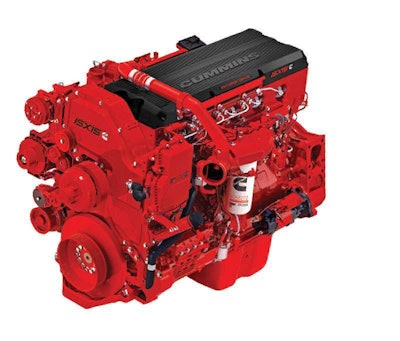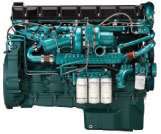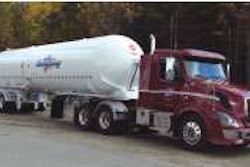Under the microscope
OEMs reluctant to extend oil drain intervals on latest engines
While the majority of 2010 engines use selective catalytic reduction to reduce emissions, SCR wasn’t intended to lower the nitrogen oxides (NOx) from the typical 2007 engine’s output to the cleaner 0.2 standard; it actually was designed to allow the engine to make more NOx.
 The 2010 Cummins ISX has a smaller exhaust gas recirculation system because the engine uses selective catalytic reduction.
The 2010 Cummins ISX has a smaller exhaust gas recirculation system because the engine uses selective catalytic reduction.The SCR system’s additional weight and complexity was justified based largely on allowing the exhaust system to handle more NOx. Advantages included higher engine efficiency, as well as the good news that the higher NOx level in the exhaust would help keep the diesel particulate filter clear of soot without much, if any, active regeneration.
With SCR-equipped engines requiring less exhaust gas recirculation, engine internal pressure and heat stresses would be reduced for 2010. Engine oil is affected by internal temperatures, as well as the volume of soot that enters the crankcase – soot being one common byproduct of high EGR levels. The belief was that SCR-equipped engines could provide truck operators with extended change intervals and savings in oil and filter costs.
But now, more than a year after SCR’s arrival, most engine makers have yet to extend changes. The only exception is International, the one engine maker that chose to use EGR without SCR to kill NOx; they’ve improved filtration on over-the-road engines to make this practical.
But those hoping for longer drain intervals shouldn’t lose hope: We still may see some loosening of the conservative periods maintained by most engine manufacturers.
What’s different today
Higher piston temperatures on EPA ’10 engines equipped with SCR result from tuning to help optimize fuel economy. While oil analysis samples have shown only subtle changes since 2010, three engine makers say they have seen differences in two areas.
 Volvo’s EPA 2010 engines have yielded a minimal increase in oil oxidation, but not to the extent that it would affect performance.
Volvo’s EPA 2010 engines have yielded a minimal increase in oil oxidation, but not to the extent that it would affect performance.While Mack’s analysis shows the same low soot levels for both its EPA ’07 and EPA ’10 technologies, the company also has seen differences in the oil’s total base number (TBN) and total acid number (TAN). “We are still evaluating what that might mean in terms of drain intervals,” says David McKenna, director of Mack powertrain marketing.
Mack also has seen a small increase in oxidation. “We’re now running higher oil temperatures for longer periods, but the peak temperatures are no different from EPA ’07 technology,” McKenna says. Since the oils are capable of sustaining higher temperatures, drain intervals haven’t been affected.
Volvo’s EPA 2010 engines have yielded a minimal increase in oil oxidation, but not to the extent that it would affect performance. “We found that the prolonged high temperatures in EPA 2010 engines have had no effect on oil performance and do not affect drain intervals,” says Ed Saxman, director of powertrain for Volvo Trucks North America. “The oil analysis report looks very similar between ’07 and ’10 equipment.”
Cummins’ XPI common rail system allowed for increased precision of its fuel injection process. “Partly as a result of this, we’ve reduced the soot level in the oil,” says Zack Ellison, director of customer technical support.
Chevron Lubricants has seen lower levels of soot accumulate in the oil sump, increasing oil life. “Some of the newer 15-liter engines have larger oil sumps, which are allowing for potentially longer oil change intervals since there is more oil capacity to help manage soot and control acid buildup,” says Len Badal, commercial sector manager.
Down the road
While recommended change intervals have remained the same since 2010, engine makers are optimistic they still may be increased. Mack’s recommended interval for its ClearTech SCR EPA 2010 engines is the same as its EPA 2007 engines. “We’re still evaluating the opportunity to stretch the interval and believe that, with the reduced EGR flow rates, there’s an opportunity to make a change,” McKenna says.
Volvo also has maintained its recommended oil change interval from its EPA 2007 engines. “We do believe there’s the potential to eventually extend the interval,” Saxman says.
While Cummins also recommends the same intervals in 2010 as beforehand, some favorable factors affect 2010 and later engines, such as lower soot levels and the two to three more quarts of oil that drain out and can be replaced because the injector cam and its oil-retaining bushings have been removed.
“Measuring what goes into the oil and its degradation rate is a major project,” Ellison says. “You need an extremely high confidence level before you can [extend intervals].”
Daimler Trucks North America, which achieved 50,000-mile intervals with the Detroit Diesel DD15 engine in 2008, says it doesn’t plan on extending them.
International Trucks’ Big Bore engines have a centrifugal filter that separates soot from the lube, which allows the company to extend changes from 25,000 to 40,000 miles. No further extensions are being considered, says Tim Shick, director of marketing and field support, Big Bore engine business.











